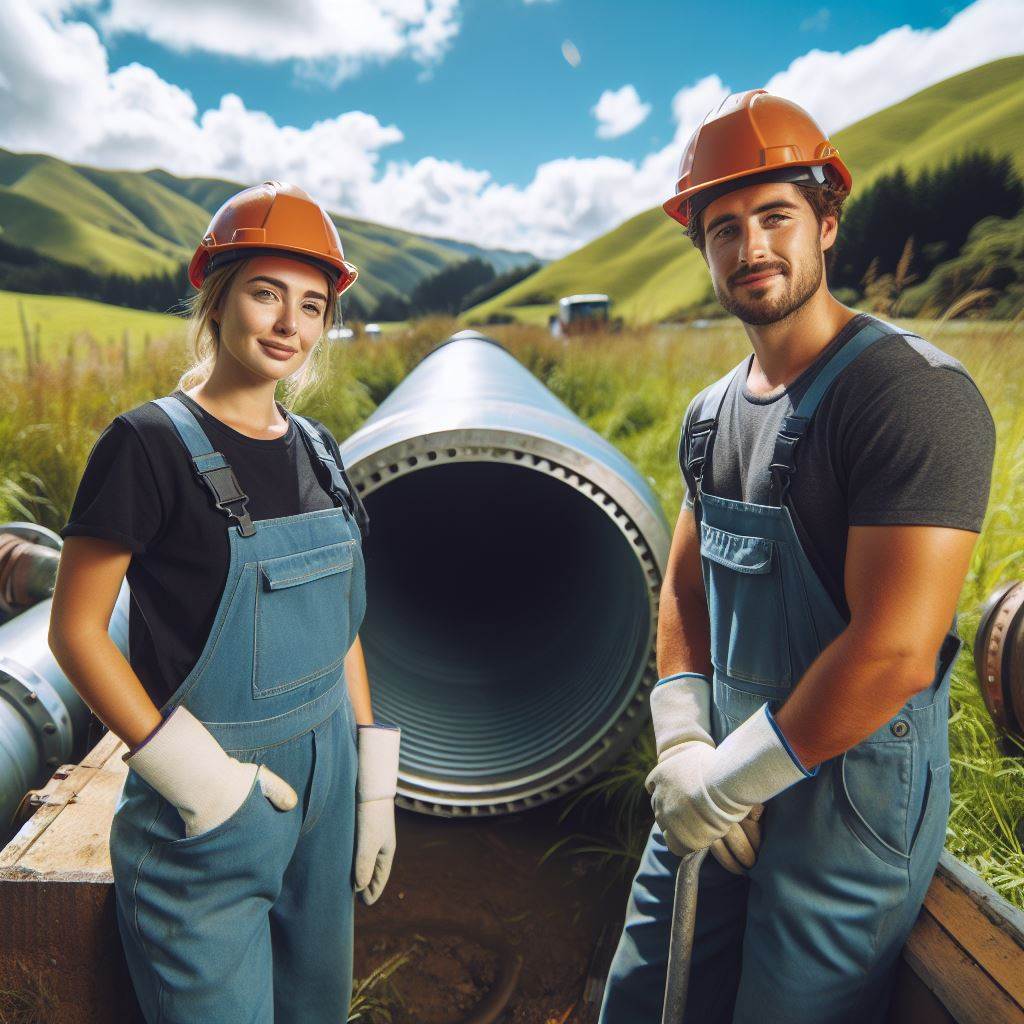Introduction
Green plumbing, an integral facet of sustainable living, champions eco-friendly practices in the realm of plumbing.
In today’s environmentally conscious society, it serves as a beacon of hope, offering solutions to mitigate the ecological footprint of traditional plumbing systems.
This blog post embarks on a journey to delve deeper into the essence of green plumbing, elucidating its principles, benefits.
Implementation strategies tailored specifically for New Zealand’s unique landscape and environmental challenges.
As we navigate through the intricacies of green plumbing, we’ll uncover innovative techniques, eco-friendly technologies, and practical tips aimed at fostering a greener, more sustainable future for generations to come.
Join us as we explore the intersection of plumbing and environmental stewardship, paving the way for a healthier planet and thriving communities in Aotearoa, New Zealand.
What is Green Plumbing?
Green plumbing is an eco-friendly approach to plumbing that aims to conserve water and energy and reduce waste.
Key principles of green plumbing include
- Water Efficiency: Green plumbing promotes the use of water-efficient fixtures and appliances to reduce water consumption.
- Energy Efficiency: It encourages the use of energy-efficient water heaters and pipe insulation to minimize energy usage.
- Recycling and Reuse: Green plumbing emphasizes the recycling and reuse of water through techniques such as greywater systems.
- Sustainable Materials: It advocates for the use of sustainable and eco-friendly plumbing materials that have a minimal impact on the environment.
How does it differ from conventional plumbing practices?
Conventional plumbing practices often prioritize convenience and cost-effectiveness over environmental considerations.
- Water Consumption: Conventional plumbing fixtures consume more water compared to their green counterparts. This leads to higher water bills and a strain on water resources.
- Energy Usage: Traditional water heaters consume more energy as they don’t prioritize energy efficiency. Green plumbing promotes the use of energy-efficient water heaters or even solar-powered systems.
- Waste Generation: Conventional plumbing practices generate more waste due to improper disposal of materials and inefficient wastewater management. Green plumbing aims to reduce waste and promote proper waste disposal.
- Carbon Footprint: Traditional plumbing methods contribute to a higher carbon footprint due to excessive water and energy consumption. Green plumbing minimizes carbon emissions through water and energy conservation.
Environmental benefits of green plumbing
- Water Conservation: By using water-efficient fixtures and appliances, green plumbing can significantly reduce water consumption, conserving this precious resource.
- Energy Conservation: Energy-efficient water heaters and insulation techniques lower energy consumption, leading to reduced greenhouse gas emissions.
- Reduced Waste: Green plumbing techniques, such as greywater recycling, help in reducing the amount of wastewater and waste generated, minimizing pollution.
- Preservation of Natural Resources: By using sustainable materials and promoting responsible water usage, green plumbing contributes to the conservation of natural resources.
- Improved Indoor Air Quality: Green plumbing practices can prevent the growth of mold and bacteria, improving indoor air quality and reducing health risks.
Essentially, green plumbing is a sustainable and environmentally responsible approach to plumbing that focuses on water and energy conservation, waste reduction, and the use of sustainable materials.
By adopting green plumbing practices, individuals and communities can contribute to preserving natural resources and minimizing their impact on the environment.
Water Conservation Techniques
Various water-saving strategies used in green plumbing
In green plumbing, there are several strategies implemented to conserve water and reduce wastage.
These techniques aim to promote sustainable water usage in homes and buildings, benefiting both the environment and homeowners. Some common water-saving strategies in green plumbing include:
- Fixing leaks promptly: Even a small leak can waste a significant amount of water over time. Green plumbers prioritize timely repairs to prevent water wastage and ensure efficient usage.
- Installing dual-flush toilets: Dual-flush toilets provide different flushing options, allowing users to select a low-water flush for liquid waste or a higher-water flush for solid waste. This helps save water without compromising sanitation.
- Using water-efficient showerheads: Low-flow showerheads are designed to reduce water consumption without sacrificing water pressure or showering experience. By using these fixtures, significant amounts of water can be saved during daily showers.
- Implementing rainwater harvesting: Green plumbing systems often incorporate rainwater harvesting techniques. Rainwater collected from rooves can be stored and reused for purposes like irrigation, toilet flushing, or laundry, reducing dependence on freshwater sources.
The importance of low-flow fixtures and appliances
Low-flow fixtures and appliances play a crucial role in water conservation efforts of green plumbing.
These water-saving solutions have become increasingly prevalent in New Zealand due to their numerous benefits. Here’s why they are considered important:
- Reduced water consumption: Low-flow fixtures, such as faucets, taps, and toilets, are designed to consume less water per use compared to traditional fixtures. This leads to a significant decrease in overall water usage, which is particularly valuable in regions with water scarcity or limited supply.
- Cost savings: By using low-flow fixtures and appliances, homeowners can enjoy lower water bills. With reduced water consumption, less water needs to be treated and supplied, reducing operational costs for water utilities.
- Environmental preservation: Conserving water helps protect freshwater ecosystems, which are vital for supporting diverse aquatic life. By using less water, the pressure on natural water sources, such as rivers and lakes, is reduced, benefiting the environment and local ecosystems.
- Compliance with regulations: Many countries, including New Zealand, have implemented regulations and building codes that encourage or mandate the use of water-saving fixtures. To meet these standards, homeowners and builders opt for low-flow fixtures and appliances.
Provide examples of water-saving technologies commonly used in NZ
New Zealand has embraced various water-saving technologies in green plumbing, enabling sustainable water usage across residential and commercial buildings. Some commonly used water-saving technologies in NZ include:
- Smart irrigation systems: These systems use advanced sensors and weather data to optimize irrigation schedules and minimize water waste. Smart irrigation adjusts watering based on local rainfall, soil moisture levels, and plant needs.
- Greywater recycling systems: Greywater, wastewater generated from sources like sinks, showers, and laundry, can be treated and reused for non-potable purposes. Greywater recycling systems collect, filter, and disinfect greywater for irrigation or toilet flushing.
- Flow restrictors: These devices limit the flow rate of water through faucets and showerheads, reducing water consumption without compromising functionality. Flow restrictors are easily installed and can be adjusted to meet individual preferences.
- Water-efficient appliances: NZ encourages the use of appliances with high energy star ratings and water-saving features. Water-efficient washing machines and dishwashers consume less water per cycle, promoting efficient usage.
By adopting these water-saving strategies, implementing low-flow fixtures and appliances, and utilizing water-saving technologies.
New Zealand’s green plumbing practices contribute not only to saving water but also to preserving the environment and promoting sustainable living.
Read: Top Carpentry Courses in New Zealand
Energy Efficiency in Plumbing
Green plumbing plays a significant role in energy conservation by reducing overall energy consumption.
Energy-efficient pumps and systems
Green plumbing practices involve the use of energy-efficient pumps and systems. These devices help conserve energy by reducing electricity usage.
Proper insulation
One vital aspect of energy efficiency in plumbing is proper insulation. Insulating pipes prevents heat loss, reducing the need for hot water circulation and water heating.
Pipe design
The design of pipes also affects energy efficiency. Well-designed plumbing systems minimize pressure drop and turbulence, reducing energy waste during water flow.
Hot water recirculation
Green plumbing utilizes hot water recirculation systems, reducing the wait time for hot water and minimizing water wastage.
Water-saving fixtures
Installing low-flow faucets, showerheads, and toilets can significantly reduce water consumption, consequently saving energy required for water heating.
Personalized Career Consulting
Unlock your potential with expert career advice tailored to your goals. Get personalized guidance and actionable steps toward your dream career in New Zealand.
Get StartedEfficient water heaters
Energy-efficient water heaters, such as tankless or solar-powered ones, contribute to energy conservation by reducing the amount of energy required for heating water.
Greywater recycling
Green plumbing promotes the use of greywater recycling systems, which repurpose wastewater from sinks, showers, and laundry for non-potable purposes like irrigation. This reduces the demand for fresh water.
Solar water heating
Utilizing solar energy for water heating is another energy-efficient practice in green plumbing. Solar water heaters harness the power of the sun, reducing reliance on fossil fuels.
Demand-based water heaters
Implementing demand-based water heaters can be highly energy-efficient as they only heat water when needed, avoiding energy waste from maintaining a constantly heated tank.
Leak detection and repair
Detecting and fixing leaks promptly is essential to conserve both water and energy. Even small leaks can waste substantial amounts of water and increase energy consumption.
Energy monitoring and smart systems
Green plumbing incorporates energy monitoring devices and smart systems that optimize water usage and energy consumption. These systems help homeowners track and control their energy usage effectively.
Energy-efficient appliances
Green plumbing advocates for the use of energy-efficient appliances, such as efficient dishwashers and washing machines, which consume less water and electricity.
Rainwater harvesting
Collecting rainwater for non-potable purposes, like flushing toilets and irrigation, is an energy-efficient practice promoted in green plumbing.
It reduces the demand on municipal water supplies, thus conserving energy used for water treatment and distribution.
Educational initiatives
Educating homeowners and plumbers about the benefits and techniques of energy efficiency in plumbing is crucial for widespread adoption of green practices.
Government incentives and regulations
Governments can play a vital role in promoting energy efficiency in plumbing by offering incentives for green plumbing installations and enforcing regulations for efficient fixtures.
In fact, green plumbing focuses on energy efficiency to maximize conservation efforts.
Energy-efficient pumps, proper insulation, pipe design, and other practices all contribute to reducing energy consumption in plumbing systems.
By adopting these eco-friendly practices, we can make a significant positive impact on the environment while saving energy and costs.
Read: NZ Carpentry: Skills and Tools Needed
Green Materials and Technologies
Eco-friendly materials play a crucial role in green plumbing practices, ensuring sustainability throughout the process.
Bamboo is a popular eco-friendly material due to its high growth rate and regenerative properties. Recycled copper pipes are commonly used in green plumbing as they reduce the demand for new materials.
Transform Your Career with a Professional CV and Cover Letter
Stand out to employers with an ATS-optimized resume and tailored cover letter designed to match your dream role. Let us craft your job application materials for success!
Get StartedLow-flow fixtures such as aerators and showerheads minimize water usage without compromising performance.
High-efficiency toilets with dual-flush systems provide significant water savings compared to traditional toilets.
The use of rainwater harvesting and greywater systems
Rainwater harvesting is a sustainable technique that collects rainwater and stores it for future use.
Installing a rainwater tank allows homeowners to utilize rainwater for activities such as flushing toilets and watering plants.
Greywater systems treat wastewater from sources like sinks, showers, and washing machines for non-potable purposes. Innovations like greywater recycling systems filter and disinfect greywater, making it safe for irrigation and toilet flushing.
The innovative technologies like solar-powered water heaters
Solar-powered water heaters harness the sun’s energy to heat water, reducing reliance on conventional heating methods.
These systems consist of solar collectors that absorb sunlight and transfer heat to a storage tank.
The stored hot water can then be used for various domestic purposes, reducing energy consumption.
Heat pump water heaters are another energy-efficient option that extracts heat from the surrounding air or ground.
These systems provide hot water with lower energy consumption compared to conventional electric water heaters.
Locally sourced materials contribute to sustainability by reducing transportation emissions and supporting the local economy.
Green plumbing practices also focus on using sustainable adhesives and sealants that are free from harmful chemicals.
Water-efficient irrigation systems like drip irrigation minimize water wastage by delivering water directly to plant roots.
Advanced leak detection technologies help identify and fix water leaks promptly, conserving water resources.
Boost Your Career with a Standout LinkedIn Profile
Attract recruiters and expand your network with a fully optimized LinkedIn profile tailored to highlight your strengths and professional goals. Let your profile open doors to new opportunities!
Get OptimizedSmart meters and water monitoring systems enable homeowners to track their water usage and identify areas for improvement.
Cutting-edge technologies like greywater treatment using membrane bioreactors ensure efficient water purification.
These systems use membranes with small pores to filter out pollutants, producing high-quality recycled water.
Green Plumbing: Innovations and Impacts
Building design plays a role in green plumbing, with features like green roofs and permeable pavements reducing water runoff.
Green roofs consist of a vegetated layer that absorbs rainwater and provides insulation, mitigating urban heat islands.
Permeable pavements allow rainwater to infiltrate the ground, replenishing groundwater instead of causing runoff.
Rain sensors integrated into irrigation systems prevent unnecessary watering when it rains, conserving water resources.
Green plumbing practices encourage the use of non-toxic and biodegradable cleaning products to prevent water pollution.
Education and awareness programs play a vital role in promoting green plumbing practices and fostering sustainable habits.
Government incentives and regulations can encourage the adoption of green plumbing practices on a larger scale.
Green plumbing not only benefits the environment but also helps homeowners save money through reduced water and energy bills.
By embracing eco-friendly materials and technologies, green plumbing contributes to a greener and more sustainable future.
In a nutshell, green plumbing relies on the use of eco-friendly materials and innovative technologies to promote sustainability.
From bamboo and recycled copper pipes to rainwater harvesting and greywater systems, these practices aim to conserve water, reduce energy consumption, and minimize environmental impact.
By implementing green plumbing techniques, individuals and communities can contribute to a greener future while enjoying the benefits of lower utility bills and a healthier living environment.
Read: Top Carpentry Courses in New Zealand

Certifications and Regulations
Highlighting relevant certifications for eco-friendly plumbing practices in NZ
- Water Efficiency Labels: In New Zealand, plumbers can earn Water Efficiency Labels by demonstrating their knowledge and skills in conserving water through efficient plumbing systems.
- LEED Certification: The Leadership in Energy and Environmental Design (LEED) certification is recognized worldwide and attests to a building’s sustainable practices, including eco-friendly plumbing.
- Green Plumbers Certification: This certification program covers various environmentally friendly practices, such as water and energy efficiency, solar hot water, and rainwater harvesting. It promotes sustainable plumbing solutions in NZ.
- Master Plumber Green status: Master Plumbers who meet certain environmentally friendly criteria can earn the Green status, demonstrating their commitment to sustainable plumbing practices.
The role of industry organizations in promoting green plumbing
- Master Plumbers New Zealand: This organization plays a crucial role in promoting eco-friendly plumbing practices by providing guidance, resources, training, and support to plumbers in NZ.
- Green Building Council of New Zealand: The council encourages and certifies green building projects, including those with sustainable plumbing systems, through programs like Green Star.
- Sustainable Business Network: With a focus on sustainability and environmental conservation, this network brings together businesses, including plumbers, to exchange ideas and promote green practices.
- Water New Zealand: This industry organization sets standards and guidelines for water management, providing information and support to plumbers in implementing sustainable plumbing solutions.
The importance of compliance with local regulations
- Water Conservation Regulations: Compliance with regulations ensures that plumbers adhere to water conservation measures, reducing water wastage and promoting sustainable use.
- Building Codes: By complying with building codes, plumbers ensure that plumbing systems meet safety and efficiency standards, contributing to overall eco-friendly practices.
- Environmental Protection Laws: Compliance with environmental laws ensures that plumbers take necessary steps to prevent pollution, manage waste, and protect ecosystems during plumbing installations and repairs.
- Health and Safety Standards: Following health and safety regulations ensures that eco-friendly plumbing practices do not compromise the well-being of plumbers, building occupants, or the environment.
Most importantly, in New Zealand, plumbers can obtain certifications such as Water Efficiency Labels, LEED certification.
Green Plumbers Certification, and Master Plumber Green status to showcase their expertise in eco-friendly plumbing.
Industry organizations like Master Plumbers New Zealand, Green Building Council of New Zealand,
Sustainable Business Network, and Water New Zealand play pivotal roles in promoting green plumbing.
Compliance with local regulations, including water conservation regulations, building codes.
Environmental protection laws, and health and safety standards, is crucial to ensuring sustainable plumbing practices are followed effectively.
Read: Carpenter Apprenticeships in NZ Explained
Benefits and Challenges of Green Plumbing
Advantages of adopting green plumbing practices
- Significantly reduces water consumption, leading to conservation of natural resources.
- Promotes energy efficiency through the use of low-flow fixtures and water-saving technologies.
- Improves indoor air quality by minimizing the use of harmful chemicals and materials.
- Enhances the overall health and well-being of individuals by reducing exposure to toxins.
- Contributes to the sustainability efforts and helps protect the environment for future generations.
Potential cost savings for homeowners and businesses
- Reduces water bills by utilizing water-efficient fixtures and implementing leak detection systems.
- Minimizes energy expenses by using eco-friendly heating and cooling systems.
- Increases property value due to the growing demand for green homes and buildings.
- Lowers maintenance and repair costs with the installation of durable and long-lasting plumbing solutions.
- Attracts eco-conscious customers, leading to a competitive advantage for businesses.
Challenges and potential barriers to widespread adoption
- Initial costs of implementing green plumbing practices can be a deterrent for some homeowners and businesses.
- Requires specialized knowledge and skills for installation, which may limit the number of qualified professionals.
- Resistance to change and lack of awareness about the benefits of green plumbing among the general public.
- Challenges related to retrofitting existing plumbing systems to make them more eco-friendly.
- Limited availability of eco-friendly plumbing products and technologies in certain regions.
In summary, adopting green plumbing practices brings numerous benefits while also presenting challenges.
The advantages include significant water and energy savings, improved health, and environmental protection. Cost savings, increased property value, and competitive advantages are additional advantages.
However, initial costs, specialized knowledge requirements, resistance to change, retrofitting challenges, and limited availability of eco-friendly products pose obstacles to widespread adoption.
Conclusion
In this blog post, we have explored the concept of green plumbing and its benefits for New Zealand’s eco-friendly practices.
We have discussed various key points, such as the use of sustainable materials, water conservation techniques, and energy-efficient systems.
Green plumbing plays a crucial role in achieving sustainability goals.
By using environmentally friendly materials and implementing water-saving measures, we can reduce our carbon footprint and preserve our precious natural resources.
It helps in minimizing water wastage, which is essential in a country like New Zealand, where water scarcity is a significant concern.
It is important for readers to consider adopting green plumbing practices in their homes or businesses.
By making the switch to eco-friendly plumbing systems, not only can they save money on utility bills, but they can also contribute to a greener future for our planet.
Conserving water and energy will help preserve our environment for future generations.
So, whether you are planning a new construction project or renovating your existing property, consider incorporating green plumbing solutions.
Consult with a professional plumber who specializes in eco-friendly practices to ensure that your plumbing system contributes positively to sustainability goals.
Let’s all make a conscious effort to protect our environment and embrace green plumbing in our daily lives.




